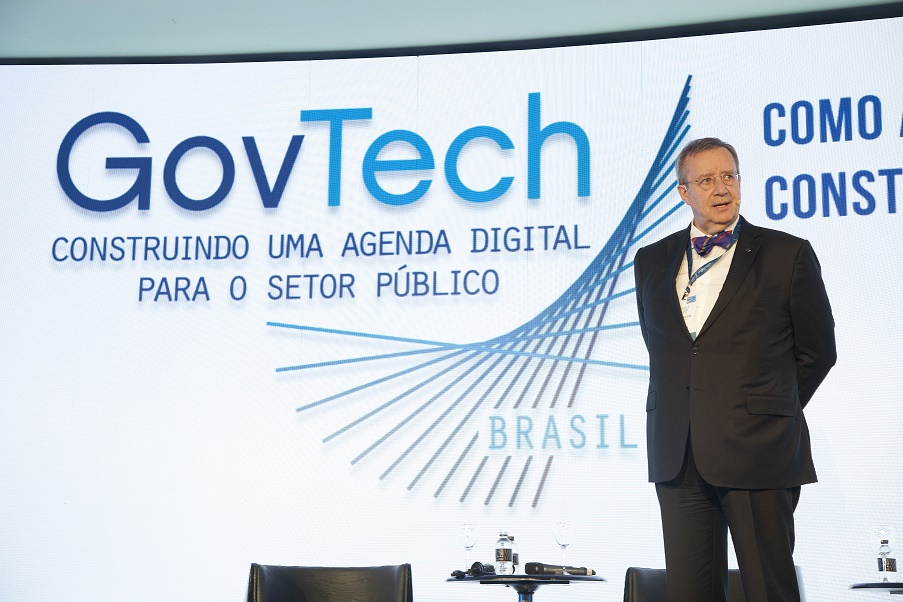
Digital identity, popularization of internet access, reduction of bureaucracy, streamlining the process of starting a business, e-voting, e-prescription, banking inclusion and encouraging innovation through startups. These are some of the bets of governments that have invested to make life easier for the population, improving public services, government transparency and creating an innovation ecosystem.
Digital government was the central theme of GovTech Brasil, an event that took place on August 6th and 7th, 2018, with the participation of Toomas Hendrik Ilves, President of Estonia between 2006 and 2016; José Clastornik, director of the Electronic Government and Information Society Agency of Uruguay; Dan Balter of Duco spoke about the successful collaboration between the government and the innovation ecosystem in Israel; and Sahil Kini, from Aspada Investments, who presented an overview of Digital India. Organized by BrazilLAB and the Institute of Technology and Society of Rio – ITS Rio, the GovTech Brazil aimed to contribute to an innovation and technology agenda for public managers in the country.
international references

Toomas Hendrik Ilves, Former President of Estonia
Coming from a country where practically all services offered to citizens can be done over the internet, Ilves believes that, from the creation of the digital identity, in 2001, it was possible to reduce the time of all services. The document features a chip, with end-to-end encryption and two-factor authentication. Among the advances, the former president highlighted the reduction of bureaucracy for opening companies, a process that takes about 15 minutes. “Our system is simultaneous, not sequential”, he says, referring to the electronic sharing of information between public bodies and comparing it to traditional bureaucracy, which usually requires citizens to wait for the approval of one body to look for others. “With this, we have undertaken a genuine revolution in bureaucracy”, says Ilves. Estonia's system made paper forms out of the country's daily life, to the point where a prescription was released digitally and accessed by any pharmacy (e-prescription) and, overcoming the skepticism of the population, the local government implemented the e-voto (e-voting), an online electoral system that has gained the support of citizens since its implementation.
José Clastornik, director of the Uruguayan Electronic Government Agency
Innovation and inclusion
Dan Balter, from Duco, explained how Israel became the nation of startups, in per capita terms, even though it is a country without natural resources and located in an area of conflict. As a first tip, he said that a country has to be willing to advance gradually, to go the “first mile”, with entrepreneurs and government willing to take risks. To begin with, it is necessary to map the challenges and processes involved, followed by the selection of the most strategic challenges. The other steps are: connecting organizations and people to the KPIs of the challenges, selection and evaluation of solutions, for subsequent construction of pilot projects with the existing infrastructure, in a continuous cycle. Until recently, Israel was the country with the most companies listed on Nasdaq. Entrepreneurial culture, abundant capital, government support for innovation, integration with the Academy and the Army are other factors that contribute to Israel's outstanding innovation.
About the Digital India Program, Sahil Kini, from Aspada Investments, said that the first step of the revolution was the provision of digital identification to 1.2 billion people, many of whom did not have any type of registration and did not have access to the programs governmental. With the document, other changes were stimulated, such as the banking of a portion of the population, hitherto marginalized, people who did not exist in the eyes of the government.
And Brazil?

During a chat with the press, the three curators of the event spoke about their expectations for Brazil. Letícia Piccolotto Ferreira, founder of BrazilLAB, Ronaldo Lemos, director of ITS Rio; and businessman and presenter Luciano Huck, are in tune with the speech. They consider that the connection between people, from the most diverse areas, can help Brazilian society to advance further in digital government and social development. They emphasize that Brazil has the advantage of being a connected country and the next president cannot do without a digital agenda, with actions, goals, prioritization and coordination of expenditures. In the opinion of the curators, the country has projects, such as the Brazilian digital strategy, however, “everything is beautiful on paper”, but there is still a lack of integration. Modernization efforts cannot focus only on the federal government: municipal administrations must also be engaged and not be afraid to innovate.












